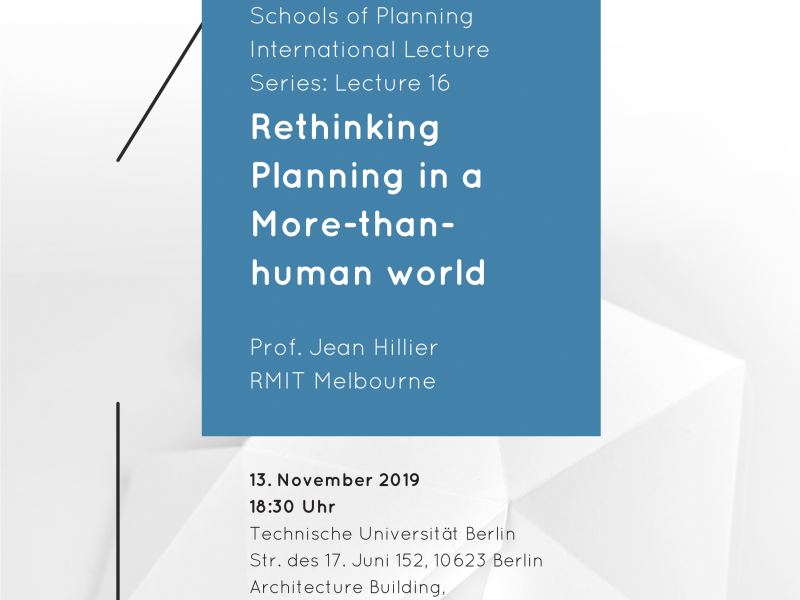News
Rethinking Planning in a More-than-human world
News
Prof. Jean Hillier | RMIT Melbourne
Wednesday 13th November 2019 | 6.30 pm
TU Berlin Building of Architecture | Main Lecture Hall, A151
Spatial planning is not external to the eco-social realities which co-produce the Anthropocene. Emeritus Professor Jean Hillier is concerned with spatial planning, its multispecies entanglements and the production of novel ecosystems, including those of damaged landscapes. Many planning systems reinforce hyper-separated categories of ‘nature’ and ‘culture’, reflected in the separation between land-use planning and environmental conservation planning. The ‘unreflected imposition of human primacy upon the desires and habits of other beings’ (Metzger, 2014: 210) and resulting asymmetric ‘negotiations’ between human planners and nonhuman others, have contributed to often-catastrophic changes across the globe. She argues that planning academics and practitioners should think carefully and critically about who speaks for (and with) the nonhuman in place making. She introduces the concept of ‘more-than-human’, as developed in geography and the environmental humanities, to explore new possibilities for productively rethinking the ontological exceptionalism of humans in planning theory and practice. She argues the need to develop inclusive, ethical relationships that can nurture possibilities for multispecies flourishing in diverse urban futures: a co-adaptive, more-than-human multispecies entanglement.
Jean Hillier is Emeritus Professor of Sustainability and Urban Planning at RMIT University, Melbourne, Australia. Her research interests include poststructural planning theory and methodology for strategic practice, planning with non-human animals, and problematisation of cultural heritage practices in spatial planning, particularly in China. Recent books include Connections: exploring contemporary planning theory and practice with Patsy Healey (2015), edited with Jonathan Metzger; Deleuze and Guattari for Planners (InPlanning e-book, 2013); Complexity and the Planning of the Built Environment (2012) edited with Gert de Roo and Joris Van Wezemael, the Ashgate Research Companion to Planning Theory: Conceptual Challenges for Spatial Planning (2010) edited with Patsy Healey. Relevant articles include: ‘Is extermination to be the legacy of Mary Gilbert’s cat?’ (with Byrne J.) Organization (2016); ‘Make kin, not cities! Multispecies entanglements and ‘becoming-world’ in planning theory’, (with MacCallum, D., Steele, W., Houston, D. and Byrne J.) Planning Theory (2017); ‘Cat-alysing attunement’, Journal of Environmental Policy & Planning (2017); ‘No Place To Go? Management of Non-Human Animal Overflows in Australia’, European Management Journal (2017).
http://cur.org.au/people/professor-jean-hillier/
It is a cooperation between the SFB 1265 Re-Figuration of Spaces and IRS – Leibniz Institute for Research on Society and Space on behalf of AESOP.
